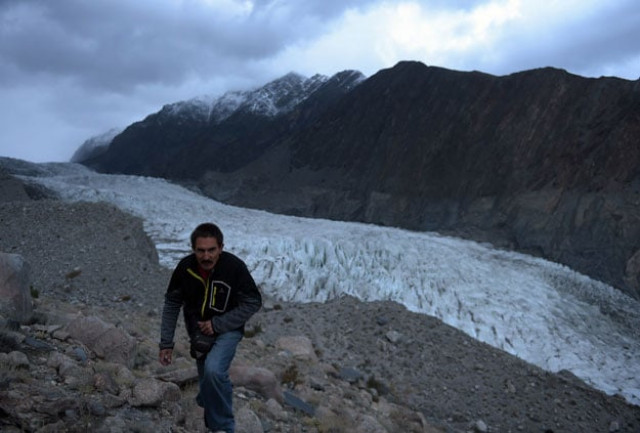Pakistan facing climate 'calamity' if warnings go unheeded
With its northern glaciers melting and its population surging, Pakistan's climate change time bomb is already ticking

In this photograph taken on September 28, 2015, a Pakistan Meteorological Department (PMD) employee takes observations at a glacier monitoring station, set at an elevation of 4,500 meters, at the 26km-long Passu glacier in the Gojal Valley. PHOTO: AFP
It sounds like the stuff of dystopian fiction but it could be the reality Pakistan is facing. With its northern glaciers melting and its population surging -- the country's climate change time bomb is already ticking.
Karachi in 2030
 In this photograph taken on September 28, 2015, a partially-submerged house is seen in Attabad Lake, which was formed following a landslide in January 2010, in Pakistan's Gojal Valley. PHOTO: AFP
In this photograph taken on September 28, 2015, a partially-submerged house is seen in Attabad Lake, which was formed following a landslide in January 2010, in Pakistan's Gojal Valley. PHOTO: AFPIn a nation facing militant violence and an unprecedented energy shortage slowing economic growth, the environment is a subject little discussed.
But the warning signs are there, including catastrophic floods which displaced millions, and a deadly heatwave this summer that killed 1,200 people.
 In this photograph taken on August 3, 2015, Pakistani residents board boats used to cross Attabad Lake, which was formed following a landslide in January 2010, in Pakistan's Gojal Valley. PHOTO: AFP
In this photograph taken on August 3, 2015, Pakistani residents board boats used to cross Attabad Lake, which was formed following a landslide in January 2010, in Pakistan's Gojal Valley. PHOTO: AFPThree of the world's most spectacular mountain ranges intersect in Pakistan's north: the Himalayas, the Hindu Khush and the Karakoram, forming the largest reservoir of ice outside the poles.
The mountain glaciers feed into the Indus River and its tributaries to irrigate the rest of the country, winding through the breadbasket of central Punjab and stretching south to finally merge with the Arabian Sea near Karachi.
The future of Pakistan, a Muslim giant whose population the UN predicts will surge past 300 million people by 2050, can be read in part by the melting of glaciers like Passu, at the gateway to China.
Climate change: Karachi could submerge by 2060, Senate panel told
From its magnificent rocky slopes, the glacial melt is obvious.
"When we would come here 25 years ago, the glacier reached that rock up there," explains Javed Akhtar, indicating an area some 500 metres (1,600 feet) from the tip of the ice.
 In this photograph taken on September 28, 2015, boats are moored in Attabad Lake, which was formed following a landslide in January 2010, in Pakistan's Gojal Valley. PHOTO: AFP
In this photograph taken on September 28, 2015, boats are moored in Attabad Lake, which was formed following a landslide in January 2010, in Pakistan's Gojal Valley. PHOTO: AFPAkhtar, his face bronzed by the sun, is a villager who has been employed by a team of glaciologists measuring the impact of climate change.
Temperatures in northern Pakistan have increased by 1.9 degrees Celsius in the past century, authorities say, causing "glof" -- glacial lake outburst floods, where the dams of such lakes abruptly rupture, sending water cascading down the slopes.
Today, thirty glacial lakes are under observation in the north. According to the Intergovernmental Panel on Climate Change (IPCC), such mass loss of water is "projected to accelerate throughout the 21st century, reducing water availability, hydropower potential, and changing seasonality of flows in regions supplied by meltwater from major mountain ranges".
 In this photograph taken on September 28, 2015, a Pakistan Meteorological Department (PMD) employee takes observations at a glacier monitoring station, set at an elevation of 4,500 meters, at the 26km-long Passu glacier in the Gojal Valley. PHOTO: AFP
In this photograph taken on September 28, 2015, a Pakistan Meteorological Department (PMD) employee takes observations at a glacier monitoring station, set at an elevation of 4,500 meters, at the 26km-long Passu glacier in the Gojal Valley. PHOTO: AFPIn Pakistan, most of the country is fed by the lush, fertile plains of one such region: Punjab.
Pakistan's climate change 'time bomb' is already ticking
Despite its growing population, Pakistan remains self-sufficient in agricultural terms, largely thanks to the rich Punjabi soil.
But in recent years the region has seen unprecedented, deadly floods that wipe out millions of acres of prime farmland.
The disasters are caused by monsoon rains, but are a bellwether for the havoc that melting glaciers could cause, with any variation in water levels threatening farmers' crops.
 In this photograph taken on September 28, 2015, a general view of Passu glacier is seen in Pakistan's Gojal Valley. PHOTO: AFP
In this photograph taken on September 28, 2015, a general view of Passu glacier is seen in Pakistan's Gojal Valley. PHOTO: AFP"When there is too much water it's not good for rice, and when there is not enough, that's also bad. And it's the same for wheat," says farmer Mohsin Ameen Chattha during a walk through his family land just outside the Punjabi capital of Lahore.
Surplus monsoon water is mostly stored in Pakistan's two large reservoirs, the Tarbela and the Mangla dams -- but, warns Ghulam Rasul, director general of Pakistan's meteorological department, the supply would hardly last 30 days.
Karachi population to increase by 50% in 15 years
"That is not sufficient," he says.
 In this photograph taken on September 28, 2015, a Pakistan Meteorological Department (PMD) employee overlooks the Passu glacier in the Gojal Valley. PHOTO: AFP
In this photograph taken on September 28, 2015, a Pakistan Meteorological Department (PMD) employee overlooks the Passu glacier in the Gojal Valley. PHOTO: AFPThroughout the rest of the year, farmers rely on the rivers, primarily the glacier-fed Indus, to irrigate their land.
For now, the production of rice and wheat is still rising.
But if the glaciers were to one day disappear, "we would be totally dependent on the monsoon. And already it varies," says Rasul.
"All this has an impact on food security" for the country, he added.
If its daily wheat production should no longer suffice, Pakistan would have to begin importing the grain -- driving the price of bread up.
 In this photograph taken on September 28, 2015, a Pakistan Meteorological Department (PMD) employee takes observations at a glacier monitoring station, set at an elevation of 4,500 meters, at the 26km-long Passu glacier in the Gojal Valley. PHOTO: AFP
In this photograph taken on September 28, 2015, a Pakistan Meteorological Department (PMD) employee takes observations at a glacier monitoring station, set at an elevation of 4,500 meters, at the 26km-long Passu glacier in the Gojal Valley. PHOTO: AFPLike the Indus, the ominous warning signs all culminate around Karachi.
The city draws almost all of its water from the river and already fails to meet even half of the four billion litres a day its inhabitants require, in part because of its inadequate pump network.
By 2050 the IPCC predicts a decrease in the freshwater supply of South Asia, particularly in large river basins such as the Indus.
That means Karachi will somehow have to manage its growing population with even less water -- a population with a significant poverty rate that will also struggle should food prices rise.
Heatwave volunteerism: These images will restore your faith in Karachi
 In this photograph taken on September 28, 2015, a Pakistan Meteorological Department (PMD) employee takes observations at a glacier monitoring station, set at an elevation of 4,500 meters, at the 26km-long Passu glacier in the Gojal Valley. PHOTO: AFP
In this photograph taken on September 28, 2015, a Pakistan Meteorological Department (PMD) employee takes observations at a glacier monitoring station, set at an elevation of 4,500 meters, at the 26km-long Passu glacier in the Gojal Valley. PHOTO: AFP"In the long term, it is a huge challenge," says Syed Mashkoorul Hasnain of the Karachi Water Company.
To make matters worse, the meteorologist Rasul predicted changes in atmospheric pressure over the Arabian Sea that could reduce the breezes that currently temper the sweltering heat of the port.
In June an unprecedented heatwave took 1,200 lives, mostly in poor neighbourhoods of Karachi -- heat traps with their massive concrete buildings, lack of shade, and the absence of aqueducts.
Could it have been a taste of the future? Back on the Passu Glacier, the research assistant Javed Akhtar is unequivocal.
"A calamity is coming," he warns.
 In this photograph taken on September 28, 2015, a Pakistan Meteorological Department (PMD) employee takes observations at a glacier monitoring station, set at an elevation of 4,500 meters, at the 26km-long Passu glacier in the Gojal Valley. PHOTO: AFP
In this photograph taken on September 28, 2015, a Pakistan Meteorological Department (PMD) employee takes observations at a glacier monitoring station, set at an elevation of 4,500 meters, at the 26km-long Passu glacier in the Gojal Valley. PHOTO: AFP In this photograph taken on August 3, 2015, Pakistani residents board boats used to cross Attabad Lake, which was formed following a landslide in January 2010, in Pakistan's Gojal Valley. PHOTO: AFP
In this photograph taken on August 3, 2015, Pakistani residents board boats used to cross Attabad Lake, which was formed following a landslide in January 2010, in Pakistan's Gojal Valley. PHOTO: AFP In this photograph taken on August 3, 2015, Pakistani residents board boats used to cross Attabad Lake, which was formed following a landslide in January 2010, in Pakistan's Gojal Valley. PHOTO: AFP
In this photograph taken on August 3, 2015, Pakistani residents board boats used to cross Attabad Lake, which was formed following a landslide in January 2010, in Pakistan's Gojal Valley. PHOTO: AFP In this photograph taken on August 3, 2015, Pakistani residents load a motorbike onto a boat used to cross Attabad Lake, which was formed following a landslide in January 2010, in Pakistan's Gojal Valley. PHOTO: AFP
In this photograph taken on August 3, 2015, Pakistani residents load a motorbike onto a boat used to cross Attabad Lake, which was formed following a landslide in January 2010, in Pakistan's Gojal Valley. PHOTO: AFP


















COMMENTS
Comments are moderated and generally will be posted if they are on-topic and not abusive.
For more information, please see our Comments FAQ